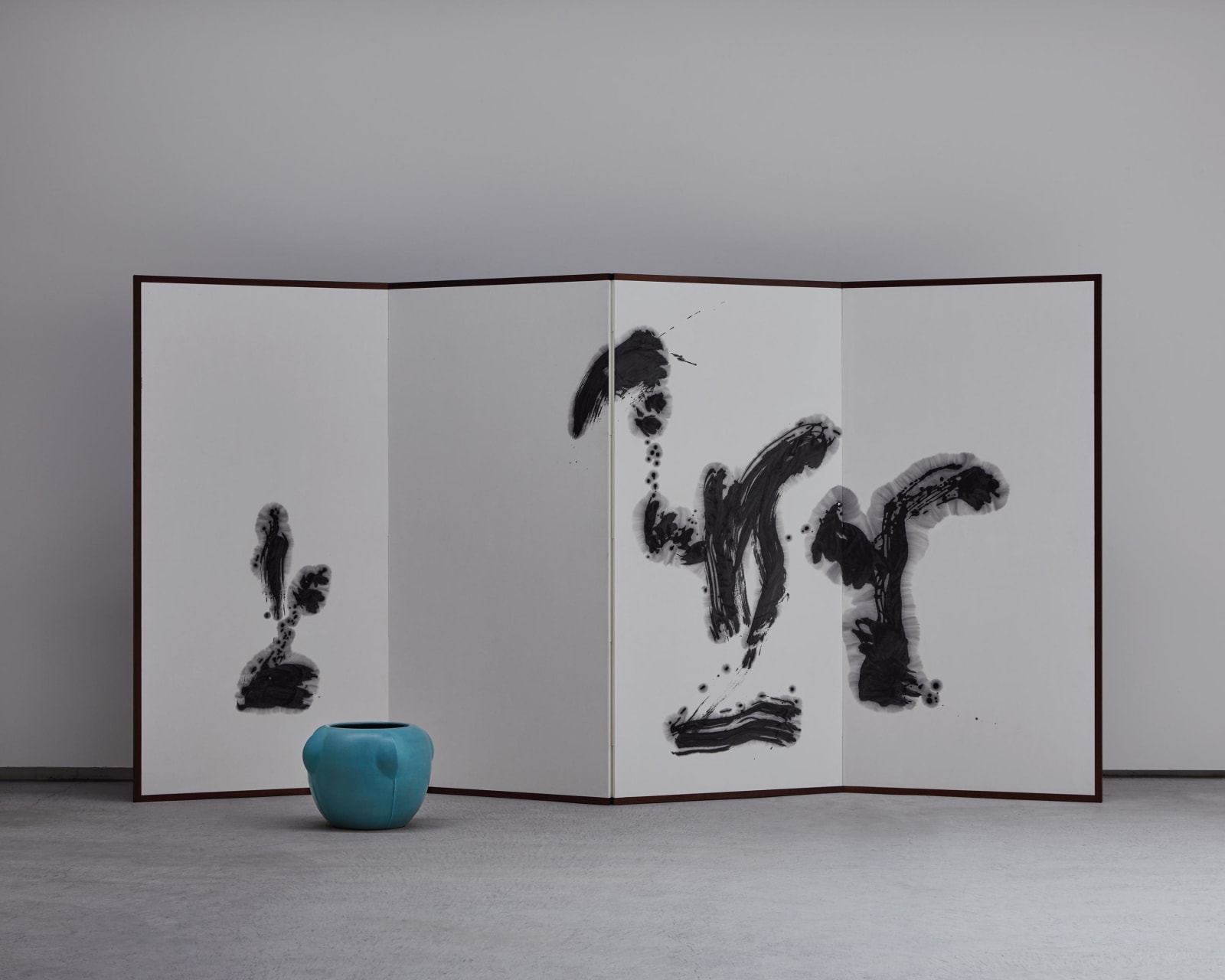Morita Shiryū (1912–1998)
Sojō ni zasu
Ink on paper, four-panel folding screen
c. 1969
With a label signed by Inada Sousai
143 x 286 cm (overall)
c. 1969
With a label signed by Inada Sousai
143 x 286 cm (overall)
Literature
Morita Shiryu Catalogue Raisonné: 1952–1998. Uji: Soryusha, 2019.
I am thinking to just endure the criticisms that reach me from society
because I cannot respond to every critical remark individually.
Inside of myself, however, I need to uphold my convictions.
Sojo ni zasu is an expression of my inner resolve to not give in.
One has to give shape to these inner motions, and since sho is about writing characters,
it requires words and characters that befit that inner state.
And in my present situation, I felt this was best represented by the phrase sojo ni zasu,
“sitting on a chopping board.”
(“Sitting on the Chopping Board,” The Mainichi Newspapers, March 21, 1953)
A year before the publication of this article, Morita formed Bokujinkai with Inoue Yuichi, Eguchi Sogen, Sekiya Yoshimichi, and Nakamura Bokushi at Ryoanji temple, Kyoto. Morita was soon criticized by fellow calligraphers and from within the art community for leaving behind his mentor Ueda Sokyu and the members of the Keiseikai art association, as well as for refusing to participate in the Nitten and other government-sponsored exhibitions. In the article quoted above, Morita responded to his and fellow Bokujinkai members’ critics and reasserted his determination to reform calligraphy and its rigid orthodoxies.
Morita worked first on the subject matter of “chopping board” in 1952. He revisited the theme further on in 1958–59, and once more in 1969. The present work was created around that latter date of 1969, when Morita faced renewed criticism by Bokujinkai founding member Eguchi, who had complained about Morita losing his “beginner’s mind” (i.e., the ability to start things afresh and without preconceptions; also: the rejection of hierarchy).Being challenged even by his closest allies from within the Bokujinkai, he resolved to face these attacks as if presenting himself “on a chopping board.”
Morita Shiryu (avant-garde calligrapher; 1912–1998)
Avant-garde calligrapher from Hyogo Prefecture. Like fellow artist Inoue Yuichi, Morita studied under the calligraphy master Ueda Sokyu. He co-founded the avant-garde group Bokujinkai together with Inoue and was the founder and editor of the journal Bokubi (Beauty of Ink), both of which revolutionized traditional Japanese calligraphy and spread knowledge of Japanese avant-garde calligraphy to an international audience. He was posthumously awarded the Medal of Honor with Dark Blue Ribbon.
because I cannot respond to every critical remark individually.
Inside of myself, however, I need to uphold my convictions.
Sojo ni zasu is an expression of my inner resolve to not give in.
One has to give shape to these inner motions, and since sho is about writing characters,
it requires words and characters that befit that inner state.
And in my present situation, I felt this was best represented by the phrase sojo ni zasu,
“sitting on a chopping board.”
(“Sitting on the Chopping Board,” The Mainichi Newspapers, March 21, 1953)
A year before the publication of this article, Morita formed Bokujinkai with Inoue Yuichi, Eguchi Sogen, Sekiya Yoshimichi, and Nakamura Bokushi at Ryoanji temple, Kyoto. Morita was soon criticized by fellow calligraphers and from within the art community for leaving behind his mentor Ueda Sokyu and the members of the Keiseikai art association, as well as for refusing to participate in the Nitten and other government-sponsored exhibitions. In the article quoted above, Morita responded to his and fellow Bokujinkai members’ critics and reasserted his determination to reform calligraphy and its rigid orthodoxies.
Morita worked first on the subject matter of “chopping board” in 1952. He revisited the theme further on in 1958–59, and once more in 1969. The present work was created around that latter date of 1969, when Morita faced renewed criticism by Bokujinkai founding member Eguchi, who had complained about Morita losing his “beginner’s mind” (i.e., the ability to start things afresh and without preconceptions; also: the rejection of hierarchy).Being challenged even by his closest allies from within the Bokujinkai, he resolved to face these attacks as if presenting himself “on a chopping board.”
Morita Shiryu (avant-garde calligrapher; 1912–1998)
Avant-garde calligrapher from Hyogo Prefecture. Like fellow artist Inoue Yuichi, Morita studied under the calligraphy master Ueda Sokyu. He co-founded the avant-garde group Bokujinkai together with Inoue and was the founder and editor of the journal Bokubi (Beauty of Ink), both of which revolutionized traditional Japanese calligraphy and spread knowledge of Japanese avant-garde calligraphy to an international audience. He was posthumously awarded the Medal of Honor with Dark Blue Ribbon.



